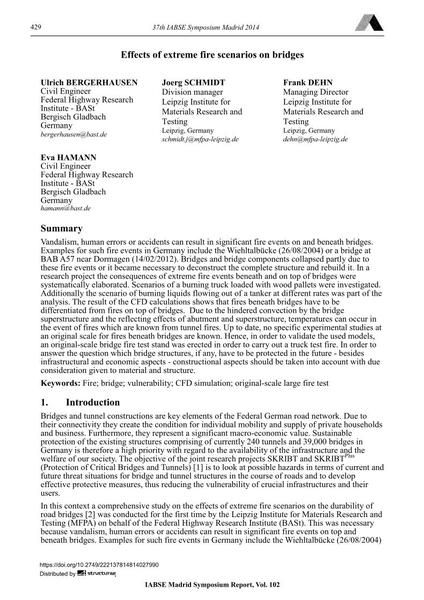Effects of extreme fire scenarios on bridges

|
|
|||||||||||
Bibliographic Details
| Author(s): |
Ulrich Bergerhausen
Joerg Schmidt Frank Dehn |
||||
|---|---|---|---|---|---|
| Medium: | conference paper | ||||
| Language(s): | English | ||||
| Conference: | IABSE Symposium: Engineering for Progress, Nature and People, Madrid, Spain, 3-5 September 2014 | ||||
| Published in: | IABSE Symposium Madrid 2014 | ||||
|
|||||
| Page(s): | 429-434 | ||||
| Total no. of pages: | 6 | ||||
| Year: | 2014 | ||||
| DOI: | 10.2749/222137814814027990 | ||||
| Abstract: |
Vandalism, human errors or accidents can result in significant fire events on and beneath bridges. Examples for such fire events in Germany include the Wiehltalbücke (26/08/2004) or a bridge at BAB A57 near Dormagen (14/02/2012). Bridges and bridge components collapsed partly due to these fire events or it became necessary to deconstruct the complete structure and rebuild it. In a research project the consequences of extreme fire events beneath and on top of bridges were systematically elaborated. Scenarios of a burning truck loaded with wood pallets were investigated. Additionally the scenario of burning liquids flowing out of a tanker at different rates was part of the analysis. The result of the CFD calculations shows that fires beneath bridges have to be differentiated from fires on top of bridges. Due to the hindered convection by the bridge superstructure and the reflecting effects of abutment and superstructure, temperatures can occur in the event of fires which are known from tunnel fires. Up to date, no specific experimental studies at an original scale for fires beneath bridges are known. Hence, in order to validate the used models, an original-scale bridge fire test stand was erected in order to carry out a truck test fire. In order to answer the question which bridge structures, if any, have to be protected in the future - besides infrastructural and economic aspects - constructional aspects should be taken into account with due consideration given to material and structure. |
||||
| Keywords: |
bridge vulnerability CFD simulation fire original-scale large fire test
|
||||
